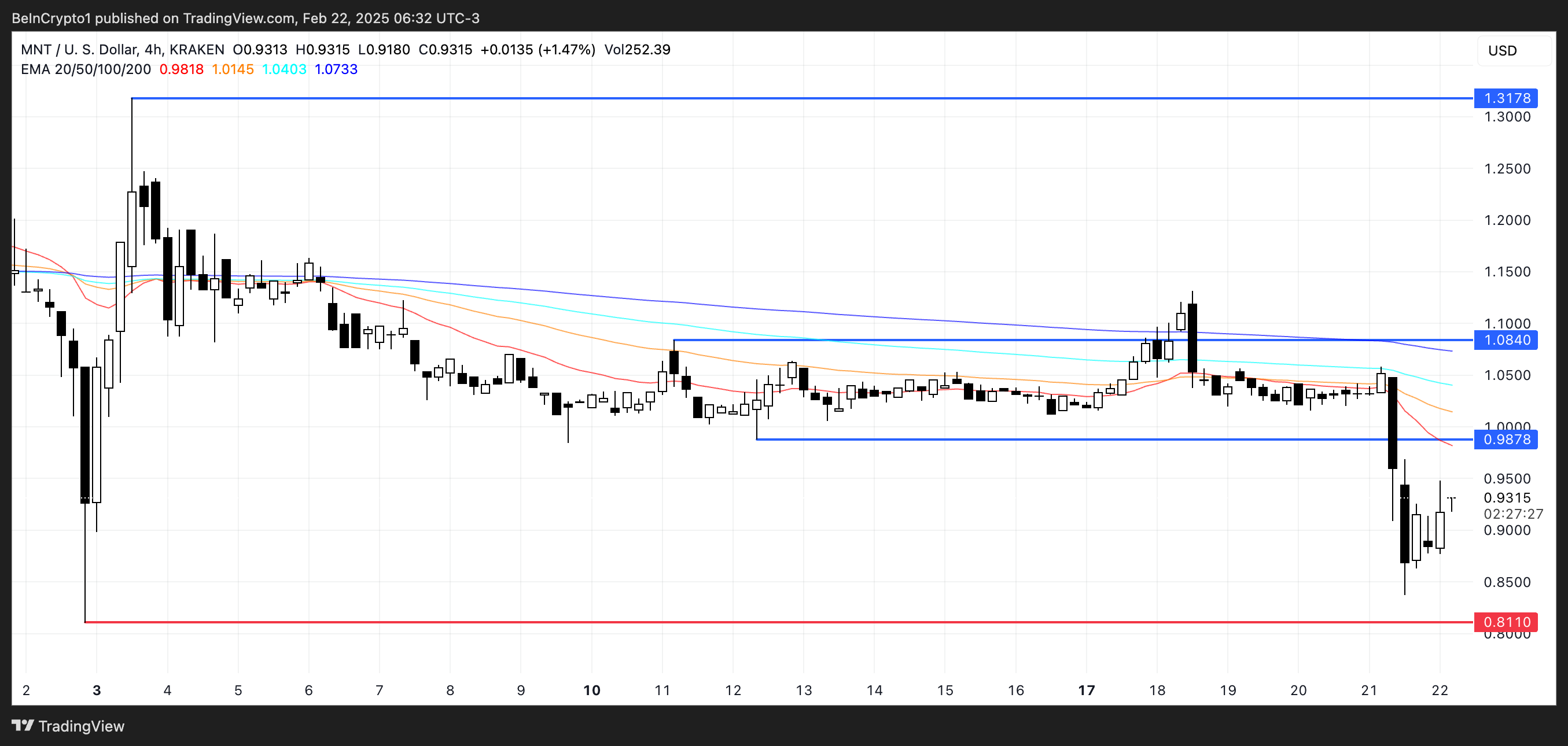| COINOTAG recommends • Exchange signup |
| 💹 Trade with pro tools |
| Fast execution, robust charts, clean risk controls. |
| 👉 Open account → |
| COINOTAG recommends • Exchange signup |
| 🚀 Smooth orders, clear control |
| Advanced order types and market depth in one view. |
| 👉 Create account → |
| COINOTAG recommends • Exchange signup |
| 📈 Clarity in volatile markets |
| Plan entries & exits, manage positions with discipline. |
| 👉 Sign up → |
| COINOTAG recommends • Exchange signup |
| ⚡ Speed, depth, reliability |
| Execute confidently when timing matters. |
| 👉 Open account → |
| COINOTAG recommends • Exchange signup |
| 🧭 A focused workflow for traders |
| Alerts, watchlists, and a repeatable process. |
| 👉 Get started → |
| COINOTAG recommends • Exchange signup |
| ✅ Data‑driven decisions |
| Focus on process—not noise. |
| 👉 Sign up → |
-
Mantle (MNT) sees a decline of more than 10% in the wake of a significant hack on the Bybit exchange, raising alarms across the crypto community.
-
The incident, linked to the infamous North Korean Lazarus Group, results in severe selling pressure on MNT, catalyzing noteworthy fluctuations in trading metrics.
-
A recent COINOTAG report noted that the hack’s fallout has led to heightened scrutiny on liquidity pools and security measures within ecosystems like Mantle.
Following a significant hack, Mantle (MNT) faces a steep decline, with critical metrics showing bearish sentiments and potential support at $0.81.
MNT RSI Plummets & Triggers Market Reactions Post-Bybit Hack
The recent hack on Bybit, linked to the notorious Lazarus Group, resulted in the loss of around $174 million, primarily in the form of cmETH, a liquidity provider for ETH in the MNT ecosystem. Mantle’s RSI witnessed a dramatic drop, spiraling from 54.7 to a low of 22.9 in mere hours after the incident. This drastic decline not only indicates an extreme oversold condition but also reflects an underlying bearish sentiment gripping the market.
Market analysts note that a Relative Strength Index (RSI) reading below 30 signals severe overselling, and Mantle’s rapid descent emphasized the panic among traders. In the aftermath, there has been a notable rebound in RSI to 39.9, hinting at a potential recovery, although it still remains in bearish territory. Market sentiment continues to be cautious, as the potential for further downside risk looms, based on the RSI’s performance.

| COINOTAG recommends • Professional traders group |
| 💎 Join a professional trading community |
| Work with senior traders, research‑backed setups, and risk‑first frameworks. |
| 👉 Join the group → |
| COINOTAG recommends • Professional traders group |
| 📊 Transparent performance, real process |
| Spot strategies with documented months of triple‑digit runs during strong trends; futures plans use defined R:R and sizing. |
| 👉 Get access → |
| COINOTAG recommends • Professional traders group |
| 🧭 Research → Plan → Execute |
| Daily levels, watchlists, and post‑trade reviews to build consistency. |
| 👉 Join now → |
| COINOTAG recommends • Professional traders group |
| 🛡️ Risk comes first |
| Sizing methods, invalidation rules, and R‑multiples baked into every plan. |
| 👉 Start today → |
| COINOTAG recommends • Professional traders group |
| 🧠 Learn the “why” behind each trade |
| Live breakdowns, playbooks, and framework‑first education. |
| 👉 Join the group → |
| COINOTAG recommends • Professional traders group |
| 🚀 Insider • APEX • INNER CIRCLE |
| Choose the depth you need—tools, coaching, and member rooms. |
| 👉 Explore tiers → |
Despite a slight recovery, traders are hesitant, as the threat of renewed selling pressure remains if buying momentum doesn’t pick up significantly. The immediate outlook focuses on whether the RSI can maintain momentum toward a neutral zone between 30 and 50, which could indicate an easing of bearish pressures.
Chaikin Money Flow (CMF) Indicates Lingering Selling Pressure
Mantle’s Chaikin Money Flow (CMF) serves as another significant indicator highlighting the ongoing market pressures post-hack. Initially at negative values, the CMF declined further after the security breach, peaking at -0.35. This trend reflects continued selling activity as investors rushed to liquidate positions.
| COINOTAG recommends • Exchange signup |
| 📈 Clear interface, precise orders |
| Sharp entries & exits with actionable alerts. |
| 👉 Create free account → |
| COINOTAG recommends • Exchange signup |
| 🧠 Smarter tools. Better decisions. |
| Depth analytics and risk features in one view. |
| 👉 Sign up → |
| COINOTAG recommends • Exchange signup |
| 🎯 Take control of entries & exits |
| Set alerts, define stops, execute consistently. |
| 👉 Open account → |
| COINOTAG recommends • Exchange signup |
| 🛠️ From idea to execution |
| Turn setups into plans with practical order types. |
| 👉 Join now → |
| COINOTAG recommends • Exchange signup |
| 📋 Trade your plan |
| Watchlists and routing that support focus. |
| 👉 Get started → |
| COINOTAG recommends • Exchange signup |
| 📊 Precision without the noise |
| Data‑first workflows for active traders. |
| 👉 Sign up → |
Currently, MNT’s CMF is moving slowly higher, now at -0.24. While this increase denotes a slight easing of selling pressure, the overall negative reading indicates an overarching sense of fear. Investors are encouraged to monitor CMF alongside price action for signs of potential recovery. Should CMF trend positively, it might signal a shift toward accumulation, pushing traders back into the market.

| COINOTAG recommends • Traders club |
| ⚡ Futures with discipline |
| Defined R:R, pre‑set invalidation, execution checklists. |
| 👉 Join the club → |
| COINOTAG recommends • Traders club |
| 🎯 Spot strategies that compound |
| Momentum & accumulation frameworks managed with clear risk. |
| 👉 Get access → |
| COINOTAG recommends • Traders club |
| 🏛️ APEX tier for serious traders |
| Deep dives, analyst Q&A, and accountability sprints. |
| 👉 Explore APEX → |
| COINOTAG recommends • Traders club |
| 📈 Real‑time market structure |
| Key levels, liquidity zones, and actionable context. |
| 👉 Join now → |
| COINOTAG recommends • Traders club |
| 🔔 Smart alerts, not noise |
| Context‑rich notifications tied to plans and risk—never hype. |
| 👉 Get access → |
| COINOTAG recommends • Traders club |
| 🤝 Peer review & coaching |
| Hands‑on feedback that sharpens execution and risk control. |
| 👉 Join the club → |
The correlation between CMF and MNT price movements remains crucial. Should the CMF revert to positive territory, it may bolster confidence among traders and facilitate a stabilization of prices, contrasting the current downward trajectory.
Bearish EMA Trends and Potential Support Levels
The Exponential Moving Average (EMA) analysis for MNT reveals an ongoing bearish trend, with short-term EMAs positioned below the long-term EMAs. This arrangement signifies sustained downward pressure, suggesting a potential test of critical support levels.

If the bearish trend continues unabated, traders should prepare for tests at the support level of $0.81. Conversely, if Mantle shows signs of reversal, the first resistance to watch will be at $0.98, with any breakthrough potentially triggering upward momentum to $1.08. Notably, a shift above this resistance could point towards a more substantial recovery toward $1.31, which represents a viable upside profit potential.
| COINOTAG recommends • Exchange signup |
| 📈 Clear control for futures |
| Sizing, stops, and scenario planning tools. |
| 👉 Open futures account → |
| COINOTAG recommends • Exchange signup |
| 🧩 Structure your futures trades |
| Define entries & exits with advanced orders. |
| 👉 Sign up → |
| COINOTAG recommends • Exchange signup |
| 🛡️ Control volatility |
| Automate alerts and manage positions with discipline. |
| 👉 Get started → |
| COINOTAG recommends • Exchange signup |
| ⚙️ Execution you can rely on |
| Fast routing and meaningful depth insights. |
| 👉 Create account → |
| COINOTAG recommends • Exchange signup |
| 📒 Plan. Execute. Review. |
| Frameworks for consistent decision‑making. |
| 👉 Join now → |
| COINOTAG recommends • Exchange signup |
| 🧩 Choose clarity over complexity |
| Actionable, pro‑grade tools—no fluff. |
| 👉 Open account → |
Conclusion
In summary, Mantle (MNT) is navigating a turbulent phase following the Bybit hack, with critical indicators such as RSI and CMF reflecting bearish sentiment across the market. The potential for recovery hinges on trading volumes and market sentiment in the near future. Traders should remain vigilant, as whether MNT can stabilize or recover will largely depend on overcoming key resistance levels and shifting CMF back to positive territory.
| COINOTAG recommends • Members‑only research |
| 📌 Curated setups, clearly explained |
| Entry, invalidation, targets, and R:R defined before execution. |
| 👉 Get access → |
| COINOTAG recommends • Members‑only research |
| 🧠 Data‑led decision making |
| Technical + flow + context synthesized into actionable plans. |
| 👉 Join now → |
| COINOTAG recommends • Members‑only research |
| 🧱 Consistency over hype |
| Repeatable rules, realistic expectations, and a calmer mindset. |
| 👉 Get access → |
| COINOTAG recommends • Members‑only research |
| 🕒 Patience is an edge |
| Wait for confirmation and manage risk with checklists. |
| 👉 Join now → |
| COINOTAG recommends • Members‑only research |
| 💼 Professional mentorship |
| Guidance from seasoned traders and structured feedback loops. |
| 👉 Get access → |
| COINOTAG recommends • Members‑only research |
| 🧮 Track • Review • Improve |
| Documented PnL tracking and post‑mortems to accelerate learning. |
| 👉 Join now → |










